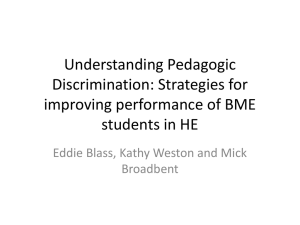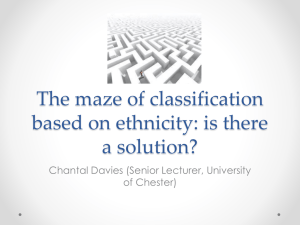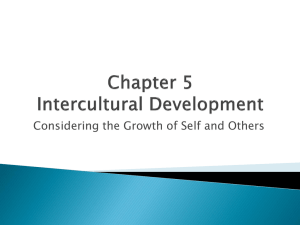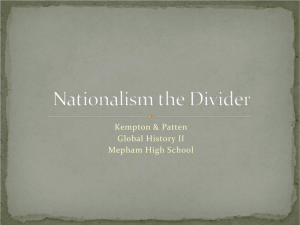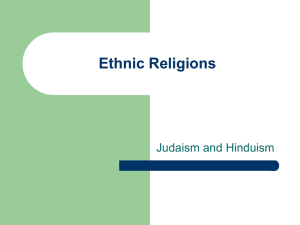to view | PowerPoint 7.03 MB
advertisement
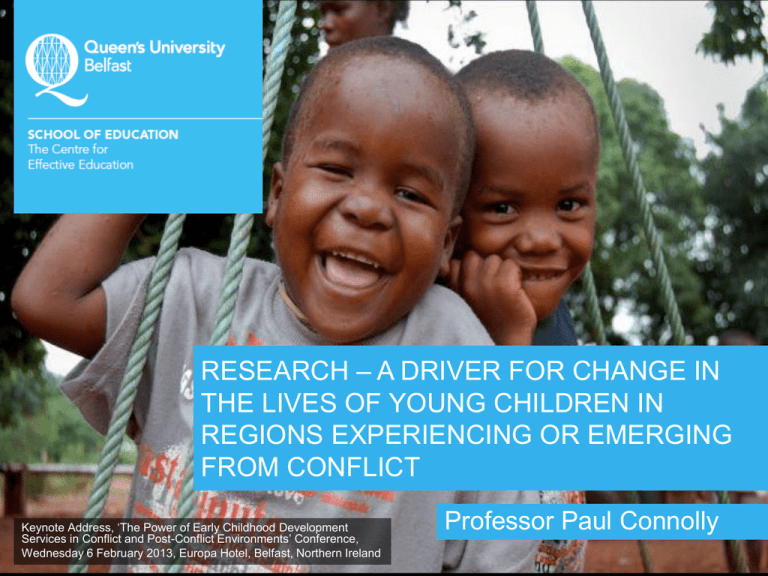
RESEARCH – A DRIVER FOR CHANGE IN THE LIVES OF YOUNG CHILDREN IN REGIONS EXPERIENCING OR EMERGING FROM CONFLICT Keynote Address, ‘The Power of Early Childhood Development Services in Conflict and Post-Conflict Environments’ Conference, Wednesday 6 February 2013, Europa Hotel, Belfast, Northern Ireland Professor Paul Connolly OVERVIEW • • • • • Some preliminaries (ethnicity, research, methodological tools) The role of research as a driver for change Example 1: Impact of divisions on young children Example 2: Effectiveness of programmes Key lessons SOME PRELIMINARIES • The nature of ethnicity and ethnic relations – Ethnicity is ‘socially constructed’ – The importance of context SOME PRELIMINARIES • The nature of ethnicity and ethnic relations – Ethnicity is ‘socially constructed’ – The importance of context • The nature of research – Paradigm wars: ‘Positivism’ versus ‘constructivism’ – A third way: ‘Critical realism’ SOME PRELIMINARIES • The nature of ethnicity and ethnic relations – Ethnicity is ‘socially constructed’ – The importance of context • The nature of research – Paradigm wars: ‘Positivism’ versus ‘constructivism’ – A third way: ‘Critical realism’ • Different Methodological tools for different jobs – Qualitative methods and case studies: experiences, perspectives, processes, indepth understanding – Surveys: broader patterns, trends, generalisations – Randomised controlled trials: effectiveness of programmes, impact THE ROLE OF RESEARCH AS A DRIVER FOR CHANGE • Understanding the impact of ethnic divisions on young children’s lives – Qualitative, case study research – Broader surveys and social epidemiological studies THE ROLE OF RESEARCH AS A DRIVER FOR CHANGE • Understanding the impact of ethnic divisions on young children’s lives – Qualitative, case study research – Broader surveys and social epidemiological studies • Understanding the effectiveness of early childhood programmes – Randomised controlled trials – Accounting for process and contextual factors – Qualitative methods and indepth case studies THE ROLE OF RESEARCH AS A DRIVER FOR CHANGE • Understanding the impact of ethnic divisions on young children’s lives – Qualitative, case study research – Broader surveys and social epidemiological studies • Understanding the effectiveness of early childhood programmes – Randomised controlled trials – Accounting for process and contextual factors – Qualitative methods and indepth case studies • The importance of research/practice partnerships – Identifying research questions – Interpreting the findings – Considering the implications for practice and dissemination EXAMPLE 1: IMPACT OF DIVISIONS ON YOUNG CHILDREN • Large body of psychological research conducted in mid-1970s to 1980s suggesting that attitudes are not consistent and fixed until ages 10-11 EXAMPLE 1: IMPACT OF DIVISIONS ON YOUNG CHILDREN • Large body of psychological research conducted in mid-1970s to 1980s suggesting that attitudes are not consistent and fixed until ages 10-11 • However, much anecdotal evidence from playgroups to suggest differently EXAMPLE 1: IMPACT OF DIVISIONS ON YOUNG CHILDREN • Large body of psychological research conducted in mid-1970s to 1980s suggesting that attitudes are not consistent and fixed until ages 10-11 • However, much anecdotal evidence from playgroups to suggest differently • Survey of 352 3-6 year olds undertaken in 2002 to listen to what children had to say in their own words.1 1 Connolly, P., Kelly, B. and Smith, A. (2009) Ethnic habitus and young children: A case study of Northern Ireland, European Early Childhood Research Journal, 17(2): 217-232. EXAMPLE 1: IMPACT OF DIVISIONS ON YOUNG CHILDREN • Showed children a range of symbols and photographs of events they were likely to see around them day-to-day and simply asked them what they could say about each one EXAMPLE 1: IMPACT OF DIVISIONS ON YOUNG CHILDREN • Showed children a range of symbols and photographs of events they were likely to see around them day-to-day and simply asked them what they could say about each one • Recorded responses verbatim and analysed them afterwards looking for overall patterns EXAMPLE 1: IMPACT OF DIVISIONS ON YOUNG CHILDREN • Showed children a range of symbols and photographs of events they were likely to see around them day-to-day and simply asked them what they could say about each one • Recorded responses verbatim and analysed them afterwards looking for overall patterns • Findings suggested need to distinguish between: (i) ethnic preferences (ii) ethnic awareness (iii) ethnic identities (iv) ethnic prejudices EXAMPLE 1: IMPACT OF DIVISIONS ON YOUNG CHILDREN (i) Ethnic Preferences Percentage of 3 Year Olds Who: Catholics Protestants Do not like Orange Marchers 18% 3% Do not like the Police 34% 15% Prefer the British Union Flag 36% 60% Prefer the Irish Tricolour Flag 64% 40% See also: Connolly, P. (2011) Using survey data to explore preschool children's ethnic awareness and attitudes, Journal of Early Childhood Research, 9(2): 175-187. EXAMPLE 1: IMPACT OF DIVISIONS ON YOUNG CHILDREN (ii) Ethnic Awareness The Terms Catholic & Protestant (7%) Colours (5%) Soccer Shirts (21%) Conflict-Related Violence (21%) Irish Dancing (31%) Parades (49%) Flags (38%) 16 EXAMPLE 1: IMPACT OF DIVISIONS ON YOUNG CHILDREN (iii) Ethnic Identities • "It's the [flag] of our country" (Protestant Boy, Aged 4) • "They're not my land … they've got all the colours that I hate" (Catholic Boy, Aged 5) • "Cos they're also Protestants as well. That's all I know about them" (Protestant Girl, Aged 6) (iv) Ethnic Prejudice • ‘They [Catholics] rob’ (Protestant Girl, Aged 4) • ‘It's a bad person [Protestants] because they want to kill all the Catholics’ (Catholic Girl, Aged 6) • ‘It's the Fenian flag [Irish Tricolour]. It's only bad people that have that colour of flag’ (Protestant girl, Aged 6) EXAMPLE 1: IMPACT OF DIVISIONS ON YOUNG CHILDREN Overall Picture % 100 90 80 70 60 50 40 30 20 10 0 Awareness Identity Prejudice 3 yrs 4 yrs 5yrs 6 yrs EXAMPLE 2: EFFECTIVENESS OF PROGRAMMES Short media messages … … followed up with: curricular resources; training and support for preschool settings; and emphasis on working with parents EXAMPLE 2: EFFECTIVENESS OF PROGRAMMES • Piloted in 2004 in 5 preschool settings (100 children aged 3-4). Small-scale trial showed that it was having positive effects in relation to: – Ability to recognise instances of exclusion – Ability to recognise how a child who is excluded feels – Willingness to play with children different to themselves Source: Connolly, P., Fitzpatrick, S., Gallagher, T. and Harris, P. (2006) Addressing diversity and inclusion in the early years in conflict-affected societies: A case study of the Media Initiative for Children – Northern Ireland, International Journal for Early Years Education, 14(3): 263-278. EXAMPLE 2: EFFECTIVENESS OF PROGRAMMES • Programme developed further and then evaluated with a largescale cluster randomised controlled trial: – – – – 1,181 children aged 3-4 years in 74 settings 868 parents 232 practitioners Four indepth qualitative case studies Source: Connolly, P., Miller, S. & Eakin, A. (2010) A Cluster Randomised Trial Evaluation of the Media Initiative for Children Programme, Belfast: Centre for Effective Education. Available at: http://www.qub.ac.uk/cee EXAMPLE 2: EFFECTIVENESS OF PROGRAMMES Key findings from large-scale trial (with effect sizes): • Increased socio-emotional development (+.34 to +.61) • Increased cultural awareness (+.38 to +.72) • Increased desire to join in with cultural activities (+.17 to +.27) although no evidence found of changes in children’s willingness to be inclusive of others EXAMPLE 2: EFFECTIVENESS OF PROGRAMMES • Effects found are those above and beyond the effects associated with normal preschool provision • Effects were the same regardless of the characteristics of the children • Effects were the same regardless of the characteristics of the settings delivering the Media Initiative EXAMPLE 2: EFFECTIVENESS OF PROGRAMMES For the parents and practitioners: • Some potentially encouraging signs found re: – increase in awareness of the need to do diversity work with young children – Increased confidence in their own ability to do this • However, for methodological reasons, none of these encouraging signs can be trusted without further research EXAMPLE 2: EFFECTIVENESS OF PROGRAMMES • Practitioners valued the training, ongoing specialist support, curriculum and resources; felt the programme impacted positively on their own skills and confidence • Parents welcomed the programme; felt it presented an important opportunity for their children to learn about diversity and develop respect for others • Children were observed to find the resources and activities appealing; activities provided an important safe space for them to explore diversity issues KEY LESSONS 1. The context-specific nature of ethnic relations and the importance of research KEY LESSONS 1. The context-specific nature of ethnic relations and the importance of research 2. The importance of multi-methods KEY LESSONS 1. The context-specific nature of ethnic relations and the importance of research 2. The importance of multi-methods 3. The need for a critical realist approach KEY LESSONS 1. The context-specific nature of ethnic relations and the importance of research 2. The importance of multi-methods 3. The need for a critical realist approach 4. The centrality of research/practice partnerships

